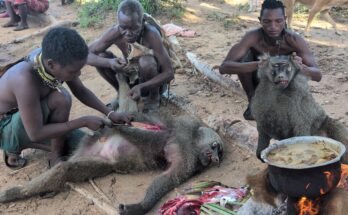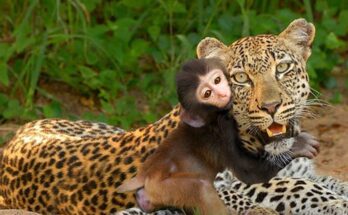
From the moment he is born, the baby monkey is not alone. His mother is his lifeline, his warmth, and his protector. In the early days, he rarely leaves her side. His tiny fingers clutch her fur as she leaps from tree to tree, her movements swift and sure. For the baby, this is his entire world—a moving bed, a source of food, and a constant comfort.
But life in the wild is no fairy tale. Within the trees live leopards, snakes, and birds of prey. On the ground lurk silent threats. The troop—the extended monkey family—offers some safety, but it’s also full of social rules the baby must one day learn to navigate. For now, though, he just watches with wide, curious eyes.
By the time he’s a few months old, the baby monkey starts to explore a little. He loosens his grip on his mother to crawl over branches, tumble onto leaves, and learn how to balance on shaky legs. His first fall scares him, and he lets out a shrill cry—but his mother is there in seconds to lift him up, hold him close, and calm his fears. These little lessons of trial and error slowly teach him how to survive.
At six months, play becomes his favorite activity. Along with other young monkeys, he leaps, chases, tumbles, and wrestles in the branches. This is not just fun—it’s practice for life. Through play, he learns coordination, strength, and even how to form social bonds. He begins to understand hierarchy, sensing which monkeys are dominant and which are submissive. In this early stage, behavior that seems silly is actually full of meaning.
As he grows, the baby monkey starts eating solid food—leaves, fruit, and the occasional insect. He mimics his mother’s movements, trying to copy the way she picks up food, chews it, or inspects it. Learning by watching is a key part of his development. He may not know it, but every step he takes is shaping the adult he will one day become.
The jungle is his school, and every tree, sound, and shadow is a lesson. Rainstorms teach him shelter. Hunger teaches him to search. The calls of his troop teach him when to move, when to hide, and when to come together.
Not everything is easy. There are moments of sickness, cold nights, and brushes with danger. Once, he gets separated from the troop during a chase, and his frantic cries echo through the trees. It’s a terrifying hour before his mother finds him again. When she does, she clutches him so tightly that both of them tremble—proof that love in the wild is as real as anywhere else.
By the time he turns one, the baby monkey has changed dramatically. He is stronger, faster, and more independent. He still depends on his mother, but not as much. Now he plays further away, climbs higher, and even stands up to older monkeys—testing the boundaries of his courage.
His first year has been one of growth, discovery, and survival. He has gone from a helpless newborn clinging to his mother’s chest to a confident young monkey learning to find his place in the troop.
What makes his story so powerful is that it’s not just about biology or instinct. It’s a story of connection, of learning, of risk and resilience. The jungle may be wild, but the journey of a baby monkey growing up in it is deeply relatable. In his innocence, his fears, and his courage, we see a reflection of ourselves.
After all, no matter the species, the path from baby to brave is always a little wild.


